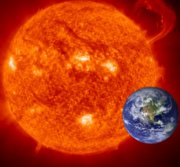 GCS Editor: We’re not entirely convinced of the CFC angle – it’s never been proven that the ozone hole (which we now know comes and goes) was affected by CFCs, but the cosmic ray theory makes sense.
GCS Editor: We’re not entirely convinced of the CFC angle – it’s never been proven that the ozone hole (which we now know comes and goes) was affected by CFCs, but the cosmic ray theory makes sense.
By John Morris, Waterloo University
Cosmic rays and chlorofluorocarbons (CFCs), both already implicated in depleting the Earth’s ozone layer, are also responsible for changes in the global climate, a University of Waterloo scientist reports in a new peer-reviewed paper.
In his paper, Qing-Bin Lu, a professor of physics and astronomy, shows how CFCs – compounds once widely used as refrigerants – and cosmic rays – energy particles originating in outer space – are mostly to blame for climate change, rather than carbon dioxide (CO2) emissions. His paper, derived from observations of satellite, ground-based and balloon measurements as well as an innovative use of an established mechanism, was published online in the prestigious journal Physics Reports.
“My findings do not agree with the climate models that conventionally thought that greenhouse gases, mainly CO2, are the major culprits for the global warming seen in the late 20th century,” Lu said. “Instead, the observed data show that CFCs conspiring with cosmic rays most likely caused both the Antarctic ozone hole and global warming. These findings are totally unexpected and striking, as I was focused on studying the mechanism for the formation of the ozone hole, rather than global warming.”
His conclusions are based on observations that from 1950 up to now, the climate in the Arctic and Antarctic atmospheres has been completely controlled by CFCs and cosmic rays, with no CO2 impact.
“Most remarkably, the total amount of CFCs, ozone-depleting molecules that are well-known greenhouse gases, has decreased around 2000,” Lu said. “Correspondingly, the global surface temperature has also dropped. In striking contrast, the CO2 level has kept rising since 1850 and now is at its largest growth rate.”
In his research, Lu discovers that while there was global warming from 1950 to 2000, there has been global cooling since 2002. The cooling trend will continue for the next 50 years, according to his new research observations.
As well, there is no solid evidence that the global warming from 1950 to 2000 was due to CO2.

Why doesn’t the media report findings such as this as well as the previous post? The Media must get excellent revenue from pro-climate scam “experts.” Never changes does it.
This is interesting. But the article also states that “CFC’s conspiring with cosmic rays most likely caused the Antarctic ozone hole and global warming.” And it adds that this is was “unexpected.” First of all, the ozone problem was/is well known, and has been for many years. We were even able to do something about it, almost if not globally (reduce and eliminate CFC’s). It is interesting that we haven’theard much about the ozone hole/s other than they were getting smaller gradually, but that the CFC’s were still present in the atmosphere and causing the same problem, but by reducing the production of them on earth the problem is controlled…
This does illustrate that serious problems can be handled globally. And if this article is true then there is much reason for optimism. It also has an element of logic that makes it seem potentially accurate to a laymen such as I. However, an issue such as global warming/cooling is a very complex one.
Whether CFCs had anything to do with changes in the Ozone layer is and was disputed science. It’s known that radiation from the sun interacting with the Earth’s atmosphere creates Ozone. We now know that the ozone “hole” comes and goes. It’s also located above the poles where the sun’s influence on the atmosphere is weak because of the angle, which is also why it’s cold there.
I have to say I believe that issue (Ozone holes over the poles) is basically agreed upon universally, and the reduction of Areosol use has made a difference. Now- with that in mind, IF there were another big change in the “holes” that would be studied and the particular agreement re: areosols would then be re-evaluated obviously. There are different types of ozone and I think you are referring to something different. To so cavalierly dismiss science, as you tend to do, is disingenuous and even dishonest.
I forgot to add the Freeon (spelling?) issue. Some people got real angry about having to pay more for the stuff in their air conditioners. But it was necessary to reduce the ozone holes too. And if you don’t recall, that particular ozone layer is Crucial to all life on this planet and that is why the change (relatively easy overall) was made without much arguing and debating, unlike the current issue has been. Many on the Right tried to make hay out of it as usual, but due to the dire nature of the problem and the relatively easy remedy, the political machinations of the Right didn’t have much effect, except for the extreme Right as usual.